
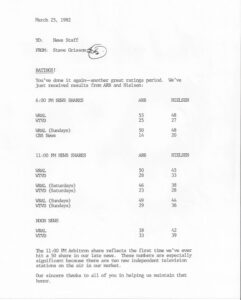 WRAL ratings March 12, 1982
WRAL ratings March 12, 1982
Action News 5 at 6:00 was already a juggernaut newscast in March 1982. Arbitron (ARB) showed WRAL’s half hour newscast with a 53 share, while Nielson logged in at 48. As for WTVD, ARB scored them with a 25 and Nielson with a 27. The very popular Bobbie Battista had transitioned to CNN four months earlier, leaving Charlie Gaddy as the solo news anchor – but the newscast didn’t miss a beat and there were bigger plans for the future.
Starting as early as 1980, WRAL was already planning the next “first” in the Raleigh/Durham television market; an hour long 6 PM newscast.
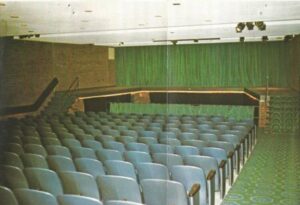 Old auditorium and stage
Old auditorium and stage
Steve Grissom, WRAL News and Communications manager (1980-1982), said during a recent interview for the CBC History Project, “At that time it was a major step. It required a huge scale-up of resources. We needed more staff, more equipment, and the newsroom was in a very compact space on the second floor of the WRAL building. (Engineering currently occupies that space on the second floor) We had no room to put anybody else, so the question was, ‘where does it go?’ I spotted the perfect place. At that time, WRAL had a rather large auditorium which was built for the use of the AJ Fletcher Opera Company. After a lot of discussion, it was agreed that the auditorium would be a great place to convert into a newsroom. The set went on the stage, and then there was an open newsroom concept with the staff working in the background.”
Construction on the conversion project started in 1980.
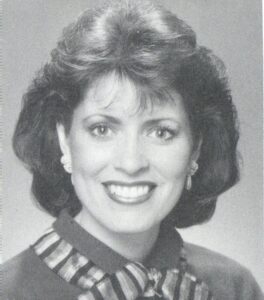 Health Desk reporter, Denece Boyer 1982
Health Desk reporter, Denece Boyer 1982
Ron Price, WRAL Assistant News Director, was hired on Labor Day, 1981. Ron recalls sorting through the data gathered from several focus groups to determine the best type feature segment that would resonate with the viewers. Two segments were developed; Health Desk with the newly hired reporter Denece Boyer and Money Desk with reporter Tim Smith.
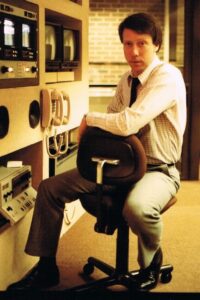 Money Desk reporter, Tim Smith 1982
Money Desk reporter, Tim Smith 1982
Tim, who was working as a reporter at WTVT in Florida, recalls his first impressions of WRAL. “I arrived at WRAL in February 1981. I drove up in a snowstorm the day of my interview. News Director Steve Grissom and I spent time outside watching SKY 5 come and go from a snow-covered helipad with snow flying everywhere from the rotor downwash. I was originally hired as an Assignment Editor. Thankfully I was quickly asked to use my on-air skills from previous jobs to create the Money Desk segment for WRAL’s new, upcoming hour-long newscast.”
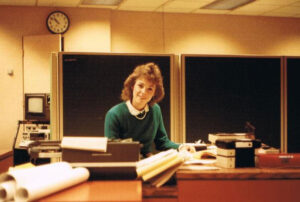 Shelley Kofler, reporter 1982
Shelley Kofler, reporter 1982
More new hires included producers Connie Lane and Laura Newborn, and reporter Shelly Kofler.
Steve Grissom also recalled one other major decision that was made at this important point of transition, not only in venue, but in content and presentation. He thought of a more instructive way to present the weather; the science/weather approach. Bob Debardelaben, the “biggest name in weather,” who had been with WRAL since 1966 started dropping hints that he was considering retirement at some point. As it turned out, that point in time came in 1989.
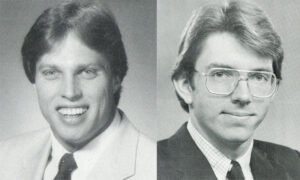 WRAL-TV Meteorologists Bill Schmidt (left) & Greg Fishel in 1982
WRAL-TV Meteorologists Bill Schmidt (left) & Greg Fishel in 1982
 Meteorologist Mike Modrick in the WeatherCenter 1982
Meteorologist Mike Modrick in the WeatherCenter 1982
With that hint, Steve felt that the timing was ripe and right to build on WRAL’s reputation as a leader in broadcast technology, so why not extend that to weather – not only with equipment, but with meteorologists. The concept of presenting weather from the angle of science led to the creation of the WeatherCenter. Three meteorologists were hired to back-up the immensely popular Debardelaben. They were Greg Fishel, Mike Modrick, and Bill Schmidt.
By October, 1981 the newsroom moved from its cramped quarters on the second floor of the broadcast building to the new open concept newsroom in the converted auditorium. The newscasts continued to air from Studio B while the news set was under construction. By early 1982, the newsroom, news set and WeatherCenter were unified. All news operations were in the new quarters, with the exception of the edit suites. Now viewers could watch a newscast and see the inner workings of a newsroom at the same time.
 Director Pam Parris-Allen 1982
Director Pam Parris-Allen 1982
The spring months of 1982 gave the news staff, production staff, and engineering time to become accustomed with the new surroundings. Directors, such as myself, became comfortable with the new camera blocking angles and working with “Shamu,” a name given to the chroma-key monitor used at the anchor desk, for graphics and interaction with reporters on remotes.
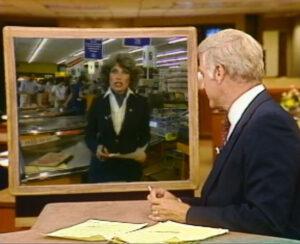 “Shamu” the monitor
“Shamu” the monitor
Yes, the monitor was named after the whale, Shamu. The wooden box with chroma-key blue painted on the front looked like a massive whale rising up from the depths of its stowed away position behind the anchor desk. It took nine seconds for it to rise into position while the camera operator jockeyed into position to frame the anchor and monitor. It was a hassle, but the video was clear via special effects. A regular monitor with a glass front was not usable due to the type of lighting instruments used for the new set. Shamu was the alternative.
The premiere date was set; June 14, 1982. About two months away from the premiere; the big grind got underway. Rehearsals were taped following the regular 30 minute newscast just about every night. Ron Price recalls, “… for weeks before the premiere we produced and ran hour long newscasts which were not aired. It was a grueling couple of months. The producers, Connie Lane and Laura Newborn and I were essentially relieved when all the saved features we had built up ahead of time finally started airing on June 14th.”
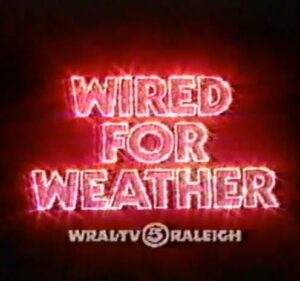 Wired for Weather ID
Wired for Weather ID
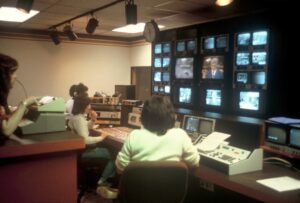 Control Room 2 about to go “live” with newscast 1982 . Producer Connie Lane (L) communicating with a remote. Pam Parris-Allen directing.
Control Room 2 about to go “live” with newscast 1982 . Producer Connie Lane (L) communicating with a remote. Pam Parris-Allen directing.
June 14, 1982 finally arrived. At 6:00 PM, the station ID aired “We’re Wired for Weather,” followed by the Action News 5 open, and then a dissolve to the studio cover shot and then to Charlie Gaddy saying “Good evening, I’m Charlie Gaddy and welcome to our new expanded edition of Action News 5.” Charlie then tossed to Ann Devlin on remote for the lead story. The launch was successful. Every element clicked along and the pacing was good. All three meteorologists appeared in the newscast. Greg Fishel reported live from Atlanta via Sat 5, Mike Modrick presented weather data from the WeatherCenter and Bob Debardelaben introduced the newest meteorologist, Bill Schmidt, to the viewers.
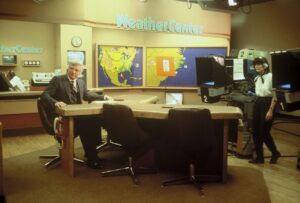 Charlie Gaddy at the anchor desk.
Charlie Gaddy at the anchor desk.
As the director of the newscast, I must say that the newscast did not feel like anything out of the ordinary. We had rehearsed the elements so many times that the execution of the production had become second nature. The studio crew hit their marks with each new segment. Thankfully the technical gremlins took the day off. The only distraction was the massive number of people pacing and milling around the newsroom, and the control room felt more like a fish bowl with onlookers peering in through the glass door. When you take a look at the newscast on the CBC History webpage, you will notice a remnant of the large group of people who eventually migrated to the back of the newsroom where they could stand and watch TV in the sitting area.
So, where are some of the people who were a part of that memorable premiere of the hour long newscast? News and Communication Manager Steve Grissom is now CEO and founder of Church Initiative in Wake Forest, N.C. Be sure to watch his interview on the CBC History website. Assistant News Director Ron Price is now an author and recently released his first novel “When Saigon Surrendered: A Kentucky Mystery.” Producer Connie Lane is now managing editor for the United Church of Christ denomination and lives in Cleveland. Money Desk reporter Tim Smith recently retired after many years as spokesperson for American Airlines in Dallas, Texas. Denece Boyer is retired and lives in her home state of Oregon. Shelley Kofler is news director at Texas Public Radio. Bill Schmidt lives in Bunn and works for Ilderton Conversion Company. Mike Modrick is chief meteorologist for KOTA in Rapid City, Iowa.
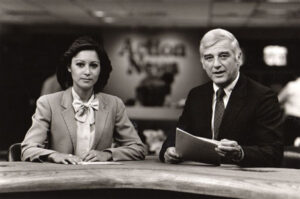 Adele Arakawa and Charlie Gaddy 1983
Adele Arakawa and Charlie Gaddy 1983
Adele Arakawa joined Charlie Gaddy as co-anchor in March, 1983. A year later, Action News 5 at 6:00 became the highest rated hour long newscast in the nation based on May, 1984 Nielson ratings. This is one reason why the 80’s is considered by many as the Golden Era of WRAL-TV. Believe me, it was a blast!
Thanks to Corp’s Pam Allen for this capcom story. Pam Parris Allen is a former WRAL newscast producer/director who now works as a researcher and producer on the CBC History Project.
WRAL ratings March 12, 1982
Old auditorium and stage
Health Desk reporter, Denece Boyer 1982
Money Desk reporter, Tim Smith 1982
At the assignment/producer area. Walter Prince (L), assignment editor, Ron Price, assistant news director, Steve Grissom (R) News and Communication 1982.
Bill Schmidt
Meteorologist Greg Fishel 1982
Meteorologist Mike Modrick in the WeatherCenter 1982
Shelley Kofler, reporter 1982
Director Pam Parris-Allen 1982
Wired for Weather ID
Control Room 2 about to go “live” with newscast 1982 . Producer Connie Lane (L) communicating with a remote. Pam Parris-Allen directing.
News set and newsroom after completion 1982
Charlie Gaddy at the anchor desk.
“Shamu” the monitor
Adele Arakawa and Charlie Gaddy 1983